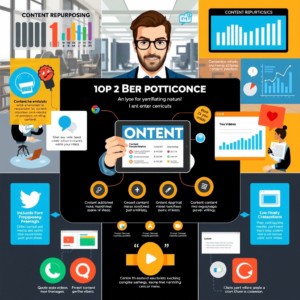Imagine this: you’re scrolling through your phone, and a video catches your eye. It’s not flashy or overly polished—it’s just someone telling a story. But something about it pulls you in. You watch until the end. You even share it with a friend.
That’s the magic of storytelling through video content.
In today’s fast-paced digital world, attention spans are short, but emotions run deep. Video has become one of the most powerful tools we have to connect, engage, and inspire action. And at the heart of effective video content is storytelling—the universal language that cuts across cultures, industries, and platforms.
Whether you’re a marketer, educator, entrepreneur, or simply someone who wants to share their message, learning how to use video to tell stories that stick can make all the difference. In this article, we’ll explore how to craft compelling narratives, build emotional connections, and create videos that people remember—and want to share.
So grab your popcorn (or your notebook), because we’re diving into the art and science of storytelling through video.
1. Know Your Audience: The First Step to Creating Meaningful Stories
Every great story starts with knowing who you’re telling it to.
Before you hit record, take time to understand your audience. Who are they? What do they care about? What challenges are they facing? When you tailor your story to resonate with your viewers on a personal level, you increase the chances that your message will stick.
For example, if you’re creating a video for small business owners, focus on themes like growth, overcoming obstacles, or work-life balance. If your audience is Gen Z, humor, authenticity, and relatability might be more effective than formal messaging.
Use data or feedback from previous videos to guide your approach. Did a particular topic get high engagement? Why do you think that was? Maybe it touched on a common frustration or celebrated a shared win.
Also, consider the platform where your video will live. A short, punchy story on TikTok might need a different tone than a longer, more reflective piece on YouTube or LinkedIn.
Knowing your audience doesn’t mean pandering—it means speaking directly to their hearts and minds. And when you do that, your story becomes less about you and more about them—which is exactly where it should be.
2. Build an Emotional Hook: Make Them Feel Something
People forget facts, but they never forget how something made them feel.
That’s why emotion is the secret sauce of memorable storytelling. Whether it’s joy, surprise, sadness, or inspiration, triggering an emotional response makes your video more engaging and easier to recall.
Think about some of the most viral videos you’ve seen. Chances are, they made you laugh, cry, or say, “Wow.” That’s no accident—they were crafted to evoke strong feelings.
So how can you do the same?
Start by identifying the core emotion behind your story. Is it hope? Nostalgia? Empowerment? Then, shape your narrative around that feeling. For instance, a brand sharing its origin story might focus on perseverance—showing early struggles and eventual triumph to connect with viewers who are also chasing dreams.
Visuals and music play a huge role here. A soft piano melody can add depth to a heartfelt moment, while quick cuts and upbeat music can inject energy into a success story.
Even the way you speak matters. Your tone, pace, and expressions should reflect the emotion you’re trying to convey. Don’t be afraid to show vulnerability—it often builds the strongest connection.
Remember: logic tells, but emotion sells. If you want your video to stick, make sure it tugs at the right heartstrings.
3. Structure Your Story Like a Movie: Beginning, Middle, and End
Just like your favorite film, every good video story needs structure.
A clear beginning, middle, and end helps your audience follow along, stay engaged, and remember what they watched. Without it, your message can feel confusing or forgettable.
Let’s break it down:
- Beginning: Start with a hook—something that grabs attention within the first few seconds. This could be a question, a surprising fact, or a visual that sparks curiosity.
- Middle: Introduce the conflict or challenge. This is where the journey happens. Show what’s at stake, what’s difficult, or what needs to change. This part keeps viewers invested and builds emotional momentum.
- End: Deliver resolution and transformation. Show how things changed because of the journey. Did someone grow? Did a problem get solved? Did a dream come true?
This classic three-act structure works whether you’re telling a 60-second Instagram Reel or a 10-minute documentary-style video.
And don’t forget the power of a strong closing line. Just like the final scene of a movie, it should leave your audience thinking, inspired—or reaching for the share button.
Structure isn’t just about order; it’s about pacing, rhythm, and giving your story a satisfying arc. So next time you plan a video, treat it like a script. Because every great story deserves to be told well.
4. Keep It Authentic: Let Your True Self Shine Through
In a world full of filters and curated perfection, authenticity is a breath of fresh air.
People crave realness. They want to see the person behind the screen—the one who stumbles, laughs, and shares genuine moments. That’s why being authentic in your video storytelling is so powerful.
You don’t need Hollywood-level production or a flawless performance to connect with your audience. In fact, sometimes imperfections make your story more relatable. A slight pause, a smile after a flubbed line, or a candid reaction can actually strengthen your bond with viewers.
Think about your favorite creators. Chances are, they feel like friends—not distant celebrities. That’s because they let their personalities shine through. You don’t have to be perfect—you just have to be you .
Authenticity also comes through in your message. Share your values, your experiences, and your perspective. Be honest about struggles and lessons learned. When you open up, others are more likely to open up too.
And here’s the bonus: audiences reward honesty with loyalty. They’ll keep coming back for more—not because your videos are perfect, but because they feel real.
So don’t overthink it. Speak naturally, act like yourself, and let your story unfold without trying too hard to impress. Sometimes the messiest moments make the most meaningful memories.
5. Call to Action: Invite Your Audience to Join the Journey (250 words)
A great story doesn’t end when the video stops.
It continues when your audience feels moved to do something—whether that’s liking, commenting, sharing, or taking a specific action related to your message.
That’s where a strong call to action (CTA) comes in.
Your CTA should feel like a natural extension of your story. Think of it as the bridge between inspiration and action. It’s not just about telling people what to do—it’s about inviting them to be part of something bigger.
Here are a few examples based on your goal:
- Engagement: “What’s a story that changed your life? Let me know in the comments.”
- Sharing: “If this video resonated with you, hit share and pass it on.”
- Conversion: “Ready to start telling your own stories? Download our free video planning guide below.”
- Community Building: “Join our group of storytellers and share your journey with us.”
The key is to make it clear, friendly, and relevant. Avoid pushy language—your audience should feel encouraged, not pressured.
Also, timing matters. Place your CTA near the end of the video, right after the emotional peak, when viewers are most engaged.
Remember, the best CTAs aren’t just about clicks—they’re about connection. So ask yourself: What would my audience want to do next after watching this?
Then give them a reason to take that step.
Conclusion: Turn Moments Into Memories
We’ve covered a lot—from knowing your audience to crafting emotional hooks, building structure, staying authentic, and guiding your viewers toward action.
At its core, storytelling through video is about turning fleeting moments into lasting memories. It’s about making people feel seen, heard, and inspired. And in a digital world full of noise, that kind of connection is priceless.
But here’s the beautiful thing: you don’t need a big budget or fancy equipment to tell a story that sticks. You just need passion, purpose, and the willingness to share something real.
So whether you’re starting a YouTube channel, launching a brand campaign, or simply documenting life’s little moments, remember this: your story matters. And when told well, it has the power to move people in ways you never imagined.
Now it’s your turn.
Grab your phone, turn on the camera, and start telling your story. Not just for views or likes—but because your voice deserves to be heard.
And who knows? Your next video might just be the one that changes someone’s day—or even their life.
What story will you tell next?
Bonus Section: Tools & Tips for Getting Started
If you’re new to video storytelling, getting started can feel overwhelming. But the truth is, you already have everything you need to begin.
Smartphone cameras today are incredibly powerful. Pair yours with a simple app like CapCut, Canva, or iMovie for editing, and you’re ready to go.
Need help organizing your ideas? Try using a storyboard template or a video planning worksheet to map out your visuals and script before recording.
Looking for background music? Sites like Epidemic Sound or Artlist offer royalty-free tracks that can elevate your video instantly.
And if you’re unsure what to talk about, start with what you know. Share a personal experience, explain a skill you’ve mastered, or introduce someone else whose story deserves to be told.
The most important tool isn’t technical—it’s courage. So take that first step. Press record. And let your story unfold.
Final Thoughts: Keep Telling Stories That Matter
Storytelling is more than just a marketing tactic or creative hobby—it’s a human instinct. We’ve been sharing stories since the dawn of time, and now we have more tools than ever to do it.
Video gives us the chance to bring those stories to life in vivid, emotional, and unforgettable ways. And when done right, it can spark conversations, build communities, and even change lives.
So don’t wait for the “perfect” moment. Start where you are. With what you have. And with the story only you can tell.
Because in a world full of content, what people really want is connection. And that begins with a single video.
Now go make one.




